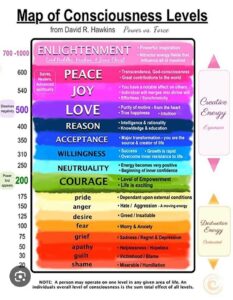
Map of Consciousness
“Map of Consciousness” is a system created by Dr. David R. Hawkins to measure levels of human consciousness, ranging from the lowest emotions to the highest states. This scale begins at 20 (shame) and rises to 1000 (enlightenment). Each level corresponds to a specific internal vibration, which influences a person's emotions, thoughts, and actions. Hawkins asserts that higher levels of consciousness, such as love, joy, and peace, bring greater harmony and light, whereas lower levels, like fear, anger, and guilt, often cause inner conflict and suffering.
This map of consciousness helps to understand where an individual stands and which stage of evolution they are in, motivating and empowering them to reach higher levels through spiritual practices and increased awareness.
How can this help you understand your level of consciousness?
Have you ever felt a lack of clarity, peace, or inner balance in life? Of course, everyone feels this way at some point or episodically. The "Map of Consciousness" is a scientific and spiritual system that helps people recognize the emotional and spiritual level they are at. Using principles of kinesiology and spiritual growth, Hawkins developed a scale to measure a person’s internal vibration, from the lowest emotions, such as shame or fear, to the highest—love, joy, and enlightenment.
The scale covers levels from 0 to 1000
- 20–50: lowest levels, such as shame, guilt, and apathy. These states are destructive and hinder personal growth.
- 100–200: emotions like fear, anger, and pride. While harmful, these emotions contain more energy, pushing people forward.
- 250–500: neutrality, courage, love, and gratitude—positive, constructive states where individuals feel more harmonious and fulfilled.
- 600–1000: highest levels, such as peace, joy, and enlightenment, associated with transcendental experiences and complete inner balance.

How does the map apply in life?
Hawkins stated that each level of consciousness reflects a specific way a person perceives and reacts to the world. For instance: - Low levels like fear or shame may lead to constant anxiety, low self-esteem, or social withdrawal. - Higher levels like love or gratitude foster stronger relationships, encourage positivity, and help discover the meaning of life. It’s important to understand that consciousness is not static—it can change based on circumstances, thoughts, emotions, and self-development efforts.
It’s important to understand that consciousness is not static—it can change based on circumstances, thoughts, emotions, and self-development efforts.
How to raise your level of consciousness
- Practice gratitude. Every day, reflect on three things you’re grateful for. This helps elevate your vibrational level.
- Release negative emotions. Observe and let go of anger, guilt, or fear, which block growth. How? Find information and practices here: video recordings
- Meditation and mindfulness practices. These help achieve inner peace and approach higher levels of consciousness.
- Live with love and empathy. Relationships built on compassion and understanding benefit both you and those around you.
- Seek knowledge and develop yourself. Searching for new insights promotes personal growth and increases consciousness.
Why is it worth trying?
This is a practical tool that can help you understand yourself and others on a deeper level. You can resolve lingering questions, improve emotional and psychological well-being, and discover more joy, meaning, and harmony in everyday life.
Try evaluating your current level—what is it? What steps can you take to move upward? The journey toward broader consciousness begins with the first step.
Join a group session to connect with your Higher Self: video recordings
Experience a personal session and receive answers to what matters most to you: personal session


